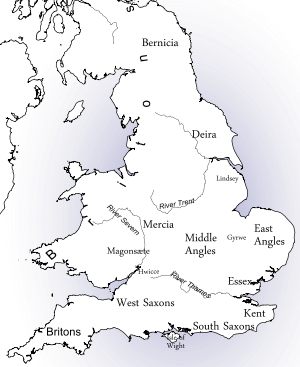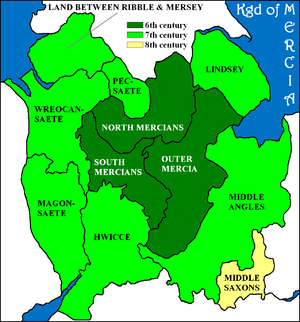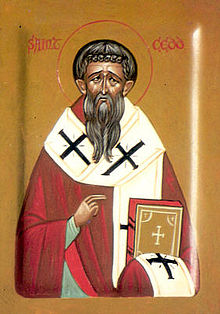- Middle Angles
-
The Middle Angles were an important ethnic or cultural group within the larger kingdom of Mercia in England in the Anglo-Saxon period.
Contents
Origins and territory
It is likely that Angles broke into the Midlands from East Anglia and the Wash in the early 6th century. Those who established their control first came to be called Middil Engli (Middle Angles). Their territory was centred in modern Leicestershire and East Staffordshire, but probably extended as far as the Cambridgeshire uplands and the Chilterns. This gave them a strategically important place within both Mercia and England as a whole, dominating both the great land routes of Watling Street and Fosse Way, and the major river route of the River Trent, together with its tributaries, the Tame and Soar.
The Middle Angles within Mercia
The Middle Angles were incorporated into the wider kingdom of Mercia, apparently well before the reign of Penda (c.626-655), who evidently felt safe enough to locate his base in their territory. He placed his eldest son, Peada, in charge of the Middle Angles as sub-king. Bede specifies the Middle Angles as the target of a four-man Christian mission accepted by Peada, who converted to Christianity, partly in order to wed the daughter of King Oswiu of Northumbria. This mission arrived in 653 and included St. Cedd. Peada's conversion and acceptance of baptism in Northumbria possibly indicates a continuing sense of disunity or local particularism within Mercia. It is unlikely that Peada could have pursued so different a course from his father, at the strategic and political centre of the Mercian kingdom, without local support among the Middle Angles.
Following the defeat and death of Penda (655), and the murder of Peada himself (656) at the instigation of his Northumbrian wife, Oswiu was able to dominate Mercia. He appointed one of the missionary priests, the Irish Diuma, bishop of the Middle Angles and the Mercians. Bede makes much of the fact that a shortage of priests compelled the appointment of one bishop to two peoples. This seems to indicate that the Middle Angles, while a central part of the Mercian kingdom, were clearly distinguished from the Mercians proper, a designation that seems to have been reserved for people settled further North and West. Diuma apparently died among the Middle Angles after a short but successful mission. His successor, Ceollach, another Irish missionary, returned home after a short time, for reasons that Bede does not specify. He was followed in turn by Trumhere and Jaruman.
Wulfhere, another son of Penda, continued to base his rule over Mercia among the Middle Angles, with the royal centre at Tamworth. In 669, after the death of Jaruman, he requested that the archbishop of Canterbury send a new bishop. This was Chad, brother of Cedd. According to Bede, Chad was designated "bishop of the Mercians and Lindsey people". In this case there is no doubt that the Middle Angles are subsumed into the category of the Mercians. The ecclesiastical centre for the entire vast region was established in Middle Angle territory, for Wulfhere donated land a short distance away from Tamworth, at Lichfield, to allow Chad to establish a monastery. It seems that the distinctions between the peoples within Mercia were gradually fading and that it was possible for them all to be described as Mercians. It is less clear whether this more accurately reflects the understanding of Chad's own time, or of Bede's, in the early 8th century.
Middle Anglia as a political and ecclesiastical centre
The Middle Anglian territory remained the political and ecclesiastical centre of the wider Mercian polity throughout its existence, reaching the peak of its importance under Offa (757-796), who dominated most of England from his base at Tamworth. Offa was able to have Lichfield declared the seat of an archdiocese at the Council of Chelsea in 787 - an arrangement that did not long survive Offa himself.
The importance of Lichfield as an ecclesiastical centre, however, long outlived the eclipse of the Mercian state in the 9th century. It survived to become one of the richest and most influential medieval dioceses, and is thus perhaps the most vivid illustration of the importance of the Middle Angles in English history.
References
- The Anglo-Saxon Chronicle: MS A v. 3, Janet Bately (Hrsg.), Brewer, Rochester (NY) 1986, ISBN 0-8599-1103-9.
- Bede's Ecclesiastical History of the English People, B. Colgrave & R.A.B. Mynors (Hrsg.), Clarendon, Oxford 1969, ISBN 0-1982-2202-5.
- Felix’s Life of Saint Guthlac, Bertram Colgrave (Hrsg.), Cambridge University Press, Campridge 1956, ISBN 0-5213-0926-3.
- Steven Basset (Hrsg.): The Origins of Anglo-Saxon Kingdoms, Leicester University Press, Leicester 1989, ISBN 0-7185-1317-7.
- James Campbell (Hrsg): The Anglo-Saxons, Phaidon, London 1982, ISBN 0-7148-2149-7.
- Wendy Davies: "Middle Anglia and the Middle Angles." in: Midland History 2 (1973-4), p. 18-20
- David Dumville: "The Tribal Hidage: an Introduction to its Texts and their History", in: Steven Basset (Hrsg.): The Origins of Anglo-Saxon Kingdoms, Leicester University Press, Leicester 1989, ISBN 0-7185-1317-7.
- David Dumville: "Essex, Middle Anglia and the Expansion of Mercia in the South East" in: Steven Basset (Hrsg.): The Origins of Anglo-Saxon Kingdoms, Leicester University Press, Leicester 1989, ISBN 0-7185-1317-7.
- Margaret Gallyon: The Early Church in Wessex and Mercia. Terence Dalton, Lavenham 1980, ISBN 0-9009-6358-1
- Peter Hunter Blair: Roman Britain and Early England. 55 B.C. - A.D. 871. Nelson, Edinburgh 1963, ISBN 0-1771-1044-9.
- D. P. Kirby: The Earliest English Kings. Unwin Hyman, London 1991, ISBN 0-0444-5691-3.
- Frank M. Stenton: Anglo-Saxon England. 3. Aufl., Oxford University Press, Oxford 1971, ISBN 0-1928-0139-2.
- Barbara Yorke: Kings and Kingdoms of Early Anglo-Saxon England. Seaby, London 1990, ISBN 1-8526-4027-8.
The Heptarchy Kingdoms Lesser kingdoms Ynys Weith (Isle of Wight) · Meonwara · Surrey · Iclingas · Lindsey · Hwicce · Magonsæte · Pencersæte · Pecsæte · Wreocensæte · Tomsæte · Haestingas · Middle Angles · Kernow (Cornwall) · Gyrwas · Southumbrians
Minor Anglo-Saxon
tribes and fiefsÆlfingas · Æbbingas · Godhelmingas · Arosæte · Beormingas · Bilsæte · Duddensæte · Cilternsæte · Eorlingas · Husmerae · Gaini · Sunningas · Brycgstowl · Icelingas · Banesbyrig · Lindisfaras · Woccingas · Nox-gaga and Oht-gaga · Middle Saxons · Middle Angles · North Mercians · Duddaæte · Gyrwas · Tetingas · Basingas · Snotingas · Spaldingas · Stoppingas · Sweordora · Westerne · Elmetsæte · Gewisse · Readingas · Weorgoran · Somersæte · Sumortūnsǣte and Glestinga · Sumorsǣte · Glastening
Categories:- Angles
- Peoples of Anglo-Saxon Mercia
- Petty kingdoms of England
Wikimedia Foundation. 2010.



